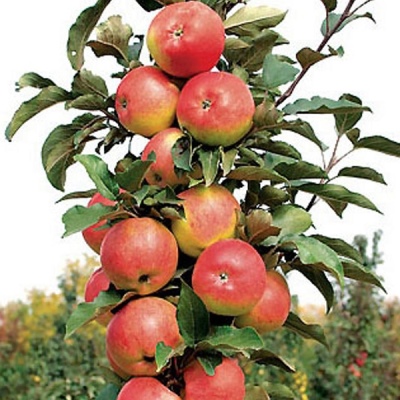
- Taste: sweet and sour
- Scent: weak
- Fruit weight, g: 170
- Fruit size: average
- Yield: high
- Ripening terms: late autumn
- Removable maturity: late September - early October
- Keeping quality: until February (in the refrigerator)
- Appointment: universal
- Growing regions: Moscow region and most of the Russian Federation
Every gardener wants to have an apple tree on the site, which is unpretentious in maintenance, does not take up much space and gives an incredibly high yield of tasty fruits. This type includes the apple variety Delight, the name of which says a lot.
Breeding history of the variety
The columnar apple tree Delight is a relatively new, but many beloved apple variety. The fruit crop was bred more than 20 years ago in Russia. The work on breeding the variety was carried out by breeders and biologists of VNIISPK headed by E.N.Sedov. The species was entered into the State Register in 2016.
Description of the variety
The apple tree Delight is a low-growing tree, reaching a height of 2 meters. The tree is characterized by a columnar crown shape with a moderate foliage density of a light green color. The crown is so compact that it looks like a pillar. The crown diameter is 50 cm.
Features, pros and cons
The late autumn apple variety is massively planted throughout the country. Along with the standard characteristics inherent for a fruit crop, this species has many advantages: good immunity to scab and pest infestation, abundant yields, high taste qualities of apples, early fruiting, sufficient keeping quality (storage is possible until the end of winter) and quick adaptation to the climate ...
Among the disadvantages are the fragility of the branches, which can break under the weight of the fruit, as well as the superficial root system, prone to freezing.
Ripening and fruiting
The period of active flowering occurs in late spring - early summer and lasts up to 11-12 days. At this time, the tree, which looks like a beautiful bush, is covered with beautiful and fragrant inflorescences. The first fruits can be tasted at the end of September, but their taste is revealed a little later, when the collected fruits lie down a little and ripen. The tree begins to bear fruit at 4-5 years of growth, but it is worth noting that fruiting is annual and stable. The tree bears harvest for 12-15 years.
Growing regions
A variety was created for cultivation in the Central Black Earth region, but over time it began to be massively grown throughout the country.
Yield
The yield indicators of this apple species are excellent. On average, up to 12-15 kg of apples can be harvested from one adult tree-column.
Fruits and their taste
Apples are medium in size (up to 170 grams) and have a harmonious sweet and sour taste with a weak aroma. The fruit is characterized by a rounded-conical shape, smooth skin with gloss, as well as an interesting color - a yellow-green base with a bright red blush. The fruit has good juiciness and pulp, so apples are universal - they are suitable for eating fresh, as well as for canning, juices, compotes.

Growing features
Before planting Rapture seedlings, it is necessary to prepare the soil - to remove weeds, moisten and fertilize. It is better to choose a place that is sunny, protected from drafts and gusty winds. Breathable, fertile sandy loam or loamy soil is considered optimal.
The apple tree is planted in autumn or spring. In regions with warm and moderate winters, seedlings can be planted at the end of September, then the root system will have time to adapt to the soil and to the approaching cold weather. There should be 3 weeks before frost. In the spring, it is recommended to plant seedlings in a well-warmed soil, when the buds on neighboring apple trees have not yet blossomed (this is mid or late April).



Pollination
This variety is partially self-fertile, so ovaries can appear without cross-pollination. Experienced gardeners and farmers recommend planting pollinating trees nearby on the site, the flowering period of which fully coincides with the appearance of flowers on the Delight apple tree.
Top dressing
The application of organic and mineral fertilizers takes place according to a certain schedule - four times a year. In the spring, top dressing is performed until the buds appear, then before the formation of flowers and after active flowering. The last dressing takes place in the fall, after the final harvest.

Frost resistance
The winter hardiness of the variety is high, however, biologists recommend taking preventive measures, especially when the tree is grown in regions with severe frosts and long winters. As insulation, mulching and wrapping the trunk with burlap are carried out.

Diseases and pests
The variety has a high immunity to scab and powdery mildew, but prevention will not hurt. Some gardeners whitewash the trunk, and in the spring they spray with special preparations.

The apple tree is a popular fruit crop among gardeners. It can be found in many summer cottages. But at the same time, such trees are often affected by various diseases.It is very important to recognize the disease in time and carry out the necessary procedures for a speedy recovery. Otherwise, the fruits will be spoiled, and the tree itself may die altogether.

Review overview
The compact apple tree is a frequent visitor to gardeners' homesteads and farm plantations. Most people who grow the Delight apple tree characterize it as non-capricious in care, quickly adapting to climatic conditions, as well as resistant to fungal diseases and pests. Many praise the incredible taste of the fruit, their considerable keeping quality, as well as the versatility of use.











































































